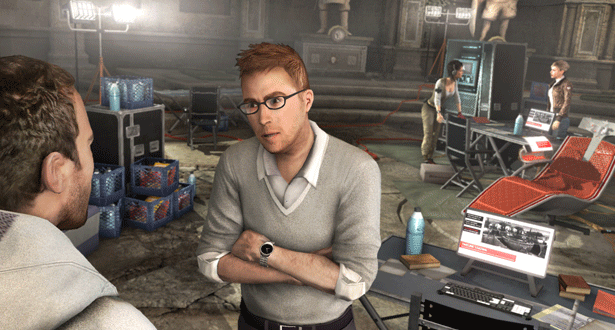
Tom Bass
Tilting Point Media is a newly formed publishing venture aimed at the mobile and tablet markets. The company plans to invest $40 million over the next three years for the development and marketing of mobile and tablet games, and in its announcement promised “groundbreaking marketing campaigns” for its titles.
As part of this plan, Titlting Point has added industry veteran Tom Bass as vice president of marketing. Bass recently stepped into this role after eight years at at publisher 2K Games, where he held the positions of director of marketing and senior director of social media and consumer relations. Bass led the worldwide marketing efforts on titles like BioShock and Sid Meier’s Civilization IV and V. Most recently, he pioneered efforts within 2K to improve social media outreach, community building, and consumer support that proved pivotal to the success of Borderlands 2 and XCOM: Enemy Unknown.
“Our current and prospective developer partners know that skillful planning and execution on marketing is pivotal to the success of their games,” said Tom Frisina, executive chairman of Tilting Point. “They need an insightful and analytical leader they can trust to deliver innovative and high-impact marketing worthy of their creations. Tom Bass fills that role perfectly, enabling our partners to focus on what they do best — making awesome games.”
Creating groundbreaking marketing campaigns is an ambitious agenda, and the [a]list daily spoke exclusively with Tom Bass about the marketing challenge that lies ahead.
[a]list daily: We all know discoverability is the core problem facing mobile game companies. Paying for installations is getting more and more expensive, and may not always get you customers that stick around. Starting without a huge audience, how do you build one?
Tom Bass: Discoverability is a huge hurdle for independent developers on tablets and mobile devices. While increasing competition forms the core of it, part of this issue is that many developers and publishers fall into established game plans that rely exclusively on paid user acquisition. What worked six months ago for a different game won’t necessarily work today.
Paid user acquisition is an important part in nearly all mobile game launches. It’s something that we take very seriously as well, and we’re building a dedicated team to manage user acquisition. The issue is that paid UA shouldn’t be the only marketing that supports the game. The old saying of “I know 50 percent of my advertising is wasted, I just don’t know which half,” no longer is applicable in the data driven world of paid UA networks, so it’s very tempting to rely solely on them to drive installs.
The problem that many developers realize when they exclusively use that strategy is that they’re not building brands or advocates, and it’s becoming a very expensive strategy as UA costs continue to rise. Users acquired with paid UA tend to retain, engage, and spend less on average than users acquired organically. Paid user acquisition needs to be complemented by great PR outreach and big ideas and efforts in marketing. The entire campaign must be driven by outstanding visual assets that have solid media support behind them, coupled with development of content for the community, and attention to the customer. There’s clearly a need for further branding than games can achieve on small install banner ads alone. User acquisition and a CPI focused approach is an essential part of what needs to be a larger marketing mix that captures mindshare and builds the brand. Hoping what worked last time will work this time and relying on cookie cutter plans are disaster strategies.
[a]list daily: Community building has become a very important part of many console, PC and online games, especially multiplayer online games. Mobile games have not had that so much, perhaps because that industry has mostly been focused on casual games. As we see more, deeper game genres appear on mobile, will community become more important? How will it differ?
Tom Bass: The communities for mobile and tablet games don’t necessarily mirror the growth and development of those from console and PC games. For example, Supercell has forums with tens of thousands of threads and over a million posts on Clash of Clans and Hay Day, but the games’ Facebook page likes don’t reflect the popularity of the titles, with Clash not even breaking 500K. The opposite holds true for Plants vs Zombies, with over 10 million likes on Facebook, while PopCap’s official forums are nearly dead. There are definitely opportunities for growth on both sides as well as challenges. Communities must be supported and nurtured; you can’t force a community to exist or attempt to move them to a medium that’s more convenient. Communities thrive on content and access, so community managers at the developer level are always going to be essential. Tilting Point helps out developers with conceptualizing and developing new content, to keep the community engagement and interest high.
[a]list daily: Video has become a powerful tool for marketing console and PC games, yet we’re only starting to see some videos for mobile games. How important do you think this is as a marketing tool?
Tom Bass: Video is going to become more and more important as a marketing tool for mobile/tablet games, but there are very few developers and publishers doing it right in this space. In console and PC, trailers are major productions, and I’m not just speaking of CG — every gameplay video is meticulously storyboarded, shot and re-shot, and edited by dedicated teams or agencies. As video install ads become more prevalent, even the 15 and 30 second videos that are produced need to be at a triple-A level to stand out from the sea of competitors. A lot of developers don’t have the bandwidth or expertise to create two dozen videos of various lengths for their campaigns, and that’s an area where Tilting Point comes in and excels. Some of our development partners are happy to hand over video production reins, while others such as Uber consistently put out excellent content, as evidenced by the Toy Rush announce trailer they recently produced.
[a]list daily: Looking ahead at the mobile market for the next year or two, what’s the biggest opportunity for you as a publisher of diverse titles? What’s the biggest challenge?
Tom Bass: For developers, one of the biggest challenges in the coming year is getting to the top 10 by themselves. The prospect of a very small team having a breakout hit is going to be less and less likely if they’re operating strictly on their own. But there haven’t been many options for developers other than antiquated publisher models, paying your way to installs, or relationships that really only provide access to a network. The market has outgrown the traditional publishing model. That isn’t what an independent developer needs, which is why Tilting Point came to be. Developers need a different kind of partner.
[a]list daily: Is Tilting Point looking for certain types or genres of games, or will it consider a wide variety? Why or why not?
Tom Bass: The games we’re working on with our partners represent a wide variety of genres and target audiences. There’s a consistent theme though — and that’s high quality, original IP games developed by the leading independent developers in the industry, all of whom we have tremendous respect for. They’re the ones that Tilting Point was built from the ground up to support.
[a]list daily: How will Tilting Point stand out among so many other mobile game publishers How much effort will go into marketing the Tilting Point brand as opposed to the individual games?
Tom Bass: Tilting Point stands out among the game publishers because we’re not a publisher. We’re a partner to independent developers, offering funding, marketing, data, and optimization services that everyone needs to succeed, but that only a handful of developers currently utilize or can perform in house. We don’t put our name as the publisher on the App Store — that slot is rightfully reserved for the teams that create the game. And since we don’t develop games ourselves, developers appreciate that they’re getting the full attention of our best team and not being pawned off to a secondary internal division. The marketing is focused on promoting the games and the developers, not Tilting Point. It sounds basic and how it should be, but it’s the antithesis of many publisher approaches.


